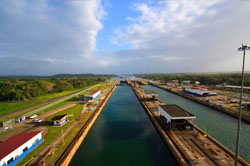Singapore, Hong Kong and…Panama
Wednesday, October 12, 2011

The world’s next major logistics center could be Central American
Is it possible for a Central American country to become the world’s third great logistics center, with the size and sophistication of Hong Kong and Singapore?
On one hand, Panama’s infrastructure – including roads, ports and airports - is developing quickly.
In addition, Panama will build a big, new canal over the next ten years.
At the same time, the country’s progress to world-class status could be slow, if it fails to produce or attract enough trained personnel to manage its new operations.
For now, Panama has several major factors in its favor.
Panamanians in top positions in business and government understand the Hong Kong-Singapore model – a small country that focuses on a strong banking system, modern super-ports and an air transport hub.
They also understand that’s it’s a potentially ideal model for their country.
Panama’s banks have been successful for decades, as investors in unstable Latin American countries sought a safe refuge for their savings.
More evidence of the importance of Panama’s financial-services sector came last year, when London-based HSBC bought Banistmo, the country’s biggest bank, with operations throughout much of Central America.
Panama’s experience with the canal, which it has run well since 1999, has taught it to work with the world’s leading shipping companies.
Meanwhile, the canal expansion project, to be completed over the next decade at an estimated cost of $5.3 billion, ensures that the country will for the next half century remain a critical shipping route between Asia and the United States east coast.
Panama is also becoming a major air-transport hub.
Panama-based COPA Airlines, which in recent years aggressively added to the company’s routes, now connects the country with 30 major cities throughout Latin America and the Caribbean, aside from flights to the United States.
For its part, the government last year completed a major expansion of the Tocumen International Airport, making it the biggest in the region.
Another plan involves investors turning Panama’s aging Caribbean-coast free zone into Latin America’s biggest wholesale shopping facility, while the state builds a new superhighway connecting it with the capital.
The free zone can also take advantage of facilities built by some of the world’s most advanced port operators, including Hong Kong’s own Hutchison Whampoa, and Denmark’s Maersk Sealand.
To reach its goals, Panama will have to overcome several obstacles.
Free zone expansion is happening slowly. Nor is it certain that many buyers from other countries will come to a bigger wholesale market, even if it gets built.
Completing a new canal on time and on budget will not be easy, especially if Panama has problems finding enough skilled people to manage the project.
Hong Kong and Singapore became global logistics centers partly because they are advanced societies, with many highly-trained engineers, computer scientists and administrators.
By contrast, Panama, like much of Latin America, is dominated by a big underclass, with limited access to higher education.
Panama and its leading companies will undoubtedly recruit top personnel in various Latin American countries and elsewhere to work on the canal and other projects.
But this costs more and is less effective than training local people, who know how the country functions and who make up a more stable workforce.
In the circumstances, Panama still has some distance to travel, before it can compare with Singapore and Hong Kong.
On the other hand, it has made an impressive start.
Fred Blaser
Chairman
República Media Group
